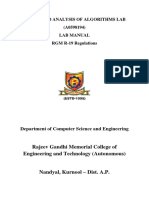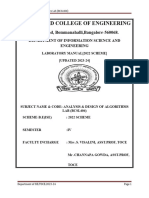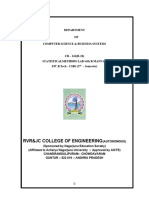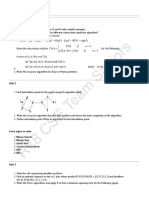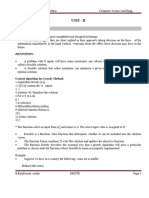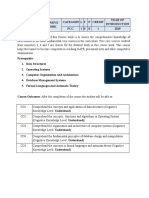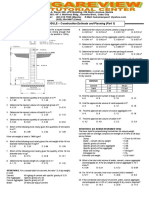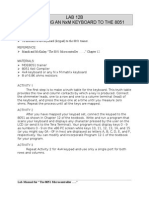Adt Lab Manual 240429 095259
Adt Lab Manual 240429 095259
Uploaded by
soumy3174Copyright:
Available Formats
Adt Lab Manual 240429 095259
Adt Lab Manual 240429 095259
Uploaded by
soumy3174Original Title
Copyright
Available Formats
Share this document
Did you find this document useful?
Is this content inappropriate?
Copyright:
Available Formats
Adt Lab Manual 240429 095259
Adt Lab Manual 240429 095259
Uploaded by
soumy3174Copyright:
Available Formats
DR.
AMBEDKAR INSTITUTE OF TECHNOLOGY
(An Autonomous Institute, Affiliated to Visvesvaraya Technological University, Belagavi, Accredited by NAAC, with ‘A’ Grade)
Near Jnana Bharathi Campus, Bengaluru – 560056
DEPARTMENT OF
COMPUTER SCIENCE AND ENGINEERING
ALGORITHM DESIGN TECHNIQUES
LABORATORY MANUAL
SUBJECT: ALGORITHM DESIGN TECHNIQUES LAB
SUBJECT CODE: 18CSL47
ACADEMIC YEAR: 2019-2020
PREPARED BY: ASHA, SOMWYA C L
SYLLABUS
Sub Title: Algorithm Design Techniques Laboratory
Sub Code:18CSL47 No. of Credits:1= 0 :0 : 1 (L-T-P) No. of lecture
Exam Duration: 3 hours CIE + SEE = 50 + 50 =100 hours/week: 3
Course objectives:
1. To study about various designing paradigms of algorithms for solving problems
2. To analyze run time of algorithms and understand fundamental algorithmic problems
3. Make the students imbibe the art of writing elegant and efficient programs as well as debugging skills.
Design, develop and implement the specified algorithms for the following problems using C/C++
Language in LINUX / Windows environment.
1 Sort a given set of elements using Bubble Sort/Selection Sort and determine the time
required to sort the elements. Plot a graph of number of elements versus time taken. Specify
the time efficiency class of this algorithm. The elements can be read from a file or can be
generated using the random number generator.
2 Implement Merge Sort algorithm to sort a given set of elements and determine the time
required to sort the elements. Repeat the experiment for different values of n, the number of
elements in the list to be sorted and plot a graph of the time taken versus n. The elements can
be read from a file or can be generated using the random number generator.
3 Sort a given set of elements using the Quicksort method and determine the time required to
sort the elements. Repeat the experiment for different values of n, the number of elements in
the list to be sorted and plot a graph of the time taken versus n.
The elements can be read from a file or can be generated using the random number generator.
4 From a given vertex in a weighted connected graph, find shortest paths to other vertices using
Dijkstra's algorithm.
5 Find Minimum Cost Spanning Tree of a given undirected graph using Kruskal's algorithm.
6 Find Minimum Cost Spanning Tree of a given undirected graph using Prim’s algorithm.
7 Obtain the Topological ordering of vertices in a given digraph.
8 a. Implement All-Pairs Shortest Paths Problem using Floyd's algorithm.
b. Compute the transitive closure of a given directed graph using Warshall's algorithm.
9 Implement 0/1 Knapsack problem using Dynamic Programming.
10 Implement Traveling Salesperson problem using Dynamic programming.
11 Implement Horspool’s algorithm for String Matching using space & time tradeoff concept
12 Implement N Queen's problem using Back Tracking.
13 Find a subset of a given set S = {sl,s2,.....,sn} of n positive integers whose sum is equal to a
given positive integer d. For example, if S= {1, 2, 5, 6, 8} and d = 9 there are two solutions
{1,2,6}and {1,8}. A suitable message is to be displayed if the given problem instance doesn't
have a solution.
2|Page Dept. of CSE, Dr. AIT
Note: In the examination each student picks one question from the lot of all 13 questions.
Course Statements Blooms
Outcomes Level
CO1 Design an algorithm using appropriate design techniques. 3
CO2 Apply and implement learned algorithm design techniques and data 3
structures to solve real world problems
CO3 Analyze and compare the performance of algorithms. 3
Course POs PSOs
Outco PO PO PO PO PO PO PO PO PO PO PO PO PS PS PSO
mes 1 2 3 4 5 6 7 8 9 10 11 12 O1 O2 3
CO1 2 3 3 3 - - - - - - - - 3 3 -
CO2 2 3 3 3 - - - - - - - - 3 3 -
CO3 2 3 2 2 - - - - - - - - 3 2 -
3|Page Dept. of CSE, Dr. AIT
TABLE OF CONTENT
PAGE
SL. NO PROGRAM
NO.
1.1 Bubble Sort 5-7
1
1.2 Selection Sort 7-9
2 Merge Sort 10-13
3 Quick Sort 14-17
4 Dijkstra’s Algorithm 18-20
5 Kruskal’s Algorithm 21-24
6 Prim’s Algorithm 25-28
7 Topological Ordering 29-32
8.1 Floyd’s Algorithm 33-35
8
8.2 Warshall’s Algorithm 36-38
9 0/1 Knapsack Problem 39-41
10 Travelling Salesman Problem 42-44
11 Horspool’s Algorithm 45-47
12 N Queen’s Problem 48-50
13 Sum Of Subset Problem 51-53
4|Page Dept. of CSE, Dr. AIT
1. Sort a given set of elements using Bubble Sort/Selection Sort and
determine the time required to sort the elements. Plot a graph of
number of elements versus time taken. Specify the time efficiency
class of this algorithm. The elements can be read from a file or can
be generated using the random number generator.
ALGORITHM BubbleSort(a,n)
//Purpose: To arrange the numbers in ascending order
//Input: n- The number of items in the array
a- Array of unsorted elements
//Output: a contains sorted elements
for j<-1 to n-1 do
for i<-0 to n-j-1 do
if a[i] > a[i+1] then
temp <- a[i]
a[i] <- a[i+1]
a[i+1] <- temp
end if
end for
end for
PROGRAM
#include<stdio.h>
#include<conio.h>
#include<time.h>
void bubblesort(int a[10000],int n)
{
int i,j,temp;
for(j=1;j<n;j++)
{
for(i=0;i<n-j;i++)
{
if(a[i]>a[i+1])
{
temp=a[i];
a[i]=a[i+1];
a[i+1]=temp;
}
}
}
}
5|Page Dept. of CSE, Dr. AIT
void main()
{
int n, a[10000],k;
clock_t st,et;
float ts;
clrscr();
printf("\n Enter Numbers of elements:");
scanf("%d", &n);
printf("\nThe Random Numbers are:\n");
for(k=1; k<=n; k++)
{
a[k]=rand();
printf("%d\t", a[k]);
}
st=clock();
bubblesort(a, n);
et=clock();
ts=et-st/CLOCKS_PER_SEC;
printf("\n Sorted Numbers are : \n ");
for(k=1; k<=n; k++)
printf("%d\t", a[k]);
printf("\nThe time taken is %f",ts);
getch();
}
OUTPUT
1)
Enter Number of elements:
10
The Random Numbers are:
4
20
16
24
5
18
38
75
10
2
The Sorted Numbers are:
6|Page Dept. of CSE, Dr. AIT
2
4
5
10
16
18
20
24
38
75
The time taken to sort 10 elements is 0.00
Time Complexity of Bubble Sort: O(n2)
ALGORITHM SelectionSort(a,n)
//Purpose: To arrange the numbers in ascending order
//Input: n- The number of items in the array
a- Array of unsorted elements
//Output: a contains sorted elements
for i<-0 to n-2 do
pos<- i
for j<-i+1 to n-1 do
if (a[j] < a[pos])
pos<-j
end for
temp <- a[pos]
a[pos] <- a[i]
a[i] <- temp
end for
PROGRAM
#include<stdio.h>
#include<conio.h>
#include<time.h>
void selectionsort(int a[10000],int n)
{
int i,j,min,temp,pos;
for(j=0;j<n-1;j++)
{
pos=j;
7|Page Dept. of CSE, Dr. AIT
for(i=j+1;i<n;i++)
{
if(a[i]<a[pos])
{
pos=i;
}
}
temp=a[j];
a[j]=a[pos];
a[pos]=temp;
}
}
void main()
{
int n, a[10000],k;
clock_t st,et;
float ts;
clrscr();
printf("\n Enter How many Numbers:");
scanf("%d", &n);
printf("\nThe Random Numbers are:\n");
for(k=1; k<=n; k++)
{
a[k]=rand();
printf("%d\t", a[k]);
}
st=clock();
selectionsort(a, n);
et=clock();
ts=et-st/CLOCKS_PER_SEC;
printf("\n Sorted Numbers are : \n ");
for(k=1; k<=n; k++)
printf("%d\t", a[k]);
printf("\nThe time taken is %f",ts);
getch();
}
OUTPUT
1>
Enter Number of elements:
10
The Random Numbers are:
8|Page Dept. of CSE, Dr. AIT
4
20
16
24
5
18
38
75
10
2
The Sorted Numbers are:
2
4
5
10
16
18
20
24
38
75
The time taken to sort 10 elements is 0.00
Time Complexity of Selection Sort:O(n2)
9|Page Dept. of CSE, Dr. AIT
2. Implement Merge Sort algorithm to sort a given set of elements
and determine the time required to sort the elements. Repeat the
experiment for different values of n, the number of elements in the
list to be sorted and plot a graph of the time taken versus n. The
elements can be read from a file or can be generated using the
random number generator.
ALGORITHM mergesort(a,low,high)
//This algorithm sorts array A [0...n-1] by recursive mergesort.
//Input: An array A [0...n-1] of orderable elements.
//Output: Array A [0...n-1] sorted in non-decreasing order
Begin
if(low>=high) return
mid<-(low+high)/2
mergesort(a,low,mid)
mergesort(a,mid+1,high)
simplemerge(a,low,mid,high)
End
ALGORITHM simplemerge(a,low,mid,high)
/*This algorithm merges the given list into 2 list till the list is totally sorted
recursively*/
//Merges two sorted arrays into one sorted array.
//Input: Arrays B [0…p-1] and C [0...q-1] both sorted.
//Output: Sorted array A [0...p+q-1] of the elements of B and C.
Begin
i<-low
j<-mid+1
k<-low
while(i<=mid and j<=high)
do
if(a[i]<a[j])
then
c[k] <-- a[i]
i<-i+1
k<-k+1
else
c[k] <-- a[j]
j<-j+1
k<-k+1
endif-else
10 | P a g e Dept. of CSE, Dr. AIT
endwhile
while(i<=mid)
do
c[k] <-- a[i]
k<-k+1
i<-i+1
endwhile
while(j<=mid)
do
c[k] <-- a[j]
k<-k+1
j<-j+1
endwhile
for i<-low to high
do
a[i]<-c[i]
endfor
End
PROGRAM
# include <stdio.h>
# include <conio.h>
#include<time.h>
void Merge(int a[], int low, int mid, int high)
{
int i, j, k, b[10000];
i=low; j=mid+1; k=low;
while ( i<=mid && j<=high )
{
if( a[i] <= a[j] )
b[k++] = a[i++] ;
else
b[k++] = a[j++] ;
}
while (i<=mid)
b[k++] = a[i++] ;
while (j<=high)
b[k++] = a[j++] ;
for(k=low; k<=high; k++)
a[k] = b[k];
}
void MergeSort(int a[], int low, int high)
{
11 | P a g e Dept. of CSE, Dr. AIT
int mid;
if(low >= high)
return;
mid = (low+high)/2 ;
MergeSort(a, low, mid);
MergeSort(a, mid+1, high);
Merge(a, low, mid, high);
delay(1);
}
void main()
{
int n, a[10000],k;
clock_t st,et;
float ts;
clrscr();
printf("\n Enter Numbers of elements:");
scanf("%d", &n);
printf("\nThe Random Numbers are:\n");
for(k=1; k<=n; k++)
{
a[k]=rand();
printf("%d\t", a[k]);
}
st=clock();
MergeSort(a, 1, n);
et=clock();
ts=et-st/CLOCKS_PER_SEC;
printf("\n Sorted Numbers are : \n ");
for(k=1; k<=n; k++)
printf("%d\t", a[k]);
printf("\nThe time taken is %f",ts);
getch();
}
OUTPUT
1)
Enter Number of elements:
10
The Random Numbers are:
4
-20416
10637
12 | P a g e Dept. of CSE, Dr. AIT
0
2004
512
1098
-20138
10775
10
The Sorted Numbers are:
-20146
-20138
0
4
10
512
1098
2004
10637
10775
The time taken to sort 10 elements is 0.00
2)
Enter the size of array
1000
The time taken to sort 1000 elements is 2.0329
Enter the size of array
2000
The time taken to sort 2000 elements is 4.0659
Enter the size of array
3000
The time taken to sort 3000 elements is 6.0989
Enter the size of array
4000
The time taken to sort 4000 elements is 8.1318
Time Complexity of Merge Sort: O(nlogn)
13 | P a g e Dept. of CSE, Dr. AIT
3. Sort a given set of elements using the Quick sort method and
determine the time required to sort the elements. Repeat the
experiment for different values of n, the number of elements in the
list to be sorted and plot a graph of the time taken versus n. The
elements can be read from a file or can be generated using the
random number generator.
ALGORITHM quicksort(a,low,high)
//Sorts a subarray by quicksort
//Input: A subarray A[l..r] of A[0..n-1],defined by its left and right indices l and r
//Output: Subarray A[l..r] sorted in nondecreasing order
Begin
if(low>high) return
k<-partition(a,low,high)
quicksort(a,low,k-1)
quicksort(a,k+1,high)
End
ALGORITHM partition(a,low,high)
/*This algorithm partitons the given list into 2 list till the list contains only 1 element
recursively*/
//Partition a subarray by using its first element as its pivot
//Input:A subarray A[l..r] of A[0..n-1],defined by its left and right indices l and r (l<r)
//Output:A partition of A[l..r],with the split position returned as this function’s value
Begin
key<-a[low]
i<-low
j<-high+1
while(i<=j)
do i<-i+1 while(key>=a[i])
do j<-j-1 while(key<a[j])
if (i<j)
then
exchange(a[i],a[j])
endif
endwhile
exchange(a[low],a[j])
return j
End
14 | P a g e Dept. of CSE, Dr. AIT
PROGRAM
# include <stdio.h>
# include <conio.h>
# include <time.h>
int partition(int a[], int low, int high)
{
int i, j, key, temp;
key=a[low];
i=low;
j=high;
while(i<=j)
{
while ( a[i] <= key )
i=i+1;
while ( a[j] > key )
j=j-1;
if(i<j)
{
temp=a[i];
a[i]=a[j];
a[j]=temp;
}
}
temp=a[low];
a[low]=a[j];
a[j]=temp;
return j;
}
void QuickSort(int a[],int low,int high)
{
int k;
if(low>=high)
return;
k=partition(a,low,high);
QuickSort(a, low, k-1);
QuickSort(a, k+1, high);
delay(1);
}
void main()
{
int n, a[10000],k;
15 | P a g e Dept. of CSE, Dr. AIT
clock_t st,et;
float ts;
clrscr();
printf("\n Enter How many Numbers:");
scanf("%d", &n);
printf("\nThe Random Numbers are:\n");
for(k=1; k<=n; k++)
{
a[k]=rand();
printf("%d\t", a[k]);
}
st=clock();
QuickSort(a, 1, n);
et=clock();
ts=et-st/CLOCKS_PER_SEC;
printf("\n Sorted Numbers are : \n ");
for(k=1; k<=n; k++)
printf("%d\t", a[k]);
printf("\nThe time taken is %f",ts);
getch();
}
OUTPUT
1)
Enter Number of elements:
10
The Random Numbers are:
4
-20416
10637
0
2004
512
1098
-20138
10775
10
The Sorted Numbers are:
-20146
-20138
0
4
16 | P a g e Dept. of CSE, Dr. AIT
10
512
1098
2004
10637
10775
The time taken to sort 10 elements is 0.00
2)
Enter the size of array
1000
The time taken to sort 1000 elements is 1.3736
Enter the size of array
2000
The time taken to sort 2000 elements is 2.6923
Enter the size of array
3000
The time taken to sort 3000 elements is 4.0659
Enter the size of array
4000
The time taken to sort 4000 elements is 5.3846
Time Complexity of Quick Sort: O(nlogn)
17 | P a g e Dept. of CSE, Dr. AIT
4. From a given vertex in a weighted connected graph, find shortest
paths to other vertices using Dijkstra's algorithm.
ALGORITHM dijikstra(cost,n,src,dist)
/*This algorithm calculates the shortest path from the given vertex in a weighted
directed graph and gives the path of that vertex to the vertex */
//Input: cost[][] – 2D array gives the weight between each pair ofvertex
// n-The number of vertices in the given weighted directed graph
// src-The vertex from where the path to all other vertex is found
// dist[] -The single dimensional array which gives the minimumdistance from
//the src to all other vertices.
//Output: shortest distance from src to all other vertices
Begin
for i<-0 to n do
dist[i]<-cost[src][i]
visited[i]<-0
end-for
visited[src]<-1
for i<-0 to n do
min<-999
for j<-0 to n do
if(visited[j]=0 and dist[j]<min)
then
min<-dist[j]
u=j
end-if
end-for
for j<-0 to n do
if(visited[j]=0 and (dist[j]+cost[u][j]<dist[j])
then
dist[j]<-dist[u]+cost[u][j]
end-if
end-for
end-for
End
18 | P a g e Dept. of CSE, Dr. AIT
PROGRAM
#include<stdio.h>
#include<conio.h>
void dijkstra(int cost[10][10],int n,int src,int dist[10])
{
int vis[10],u,min,i,j,p[10];
for(i=0;i<n;i++)
{
dist[i]=cost[src][i];
vis[i]=0;
p[i]=src;
}
vis[src]=1;
for(i=0;i<n;i++)
{
min=999;
for(j=0;j<n;j++)
{
if(vis[j]==0 && dist[j]<min)
{
min=dist[j];
u=j;
}
}
vis[u]=1;
for(j=0;j<n;j++)
{
if(vis[j]==0 && (dist[u]+cost[u][j]<dist[j]))
{
dist[j]=dist[u]+cost[u][j];
p[j]=u;
}
}
}
for(i=0;i<n;i++)
{
printf("\n\nShortest path from %d to %d\n",src,i);
j=i;
while(j!=src)
{
printf("%d <- ",j);
j=p[j];
}
19 | P a g e Dept. of CSE, Dr. AIT
printf("%d",j);
printf("::Cost=%d\n",dist[i]);
}
}
void main()
{
int cost[10][10],n,src,dist[10],i,j;
clrscr();
printf("\n\n\n\n\n\n\n Enter the number of vertices:\n");
scanf("%d",&n);
printf("\n Enter the cost matrix:\n");
for(i=0;i<n;i++)
{
for(j=0;j<n;j++)
{
scanf("%d",&cost[i][j]);
}
}
printf("\n Enter the source vertex:");
scanf("%d",&src);
dijkstra(cost,n,src,dist);
getch();
}
OUTPUT
Enter the number of vertices
6
Enter the cost adjacency matrix
999 3 999 999 6 5
3 999 1 999 999 4
999 1 999 6 999 4
999 999 6 999 8 5
6 999 999 8 999 2
5 4 4 5 2 999
Enter the source vertex
1
Shortest distance from 1 to 2 is 3
Shortest distance from 1 to 3 is 4
Shortest distance from 1 to 4 is 10
Shortest distance from 1 to 5 is 6
Shortest distance from 1 to 6 is 5
20 | P a g e Dept. of CSE, Dr. AIT
5. Find Minimum Cost Spanning Tree of a given undirected graph
using Kruskal's algorithm
ALGORITHM find(v,parent)
/*This algorithm calculates the parent of v*/
Begin
while(parent[v])
do
v<-parent[v]
endwhile
return v
End
ALGORITHM kruskal(n,cost)
/*This algorithm calculates the minimum cost spanning tree from the given weighted
undirected graph*/
//Input:cost[][]—cost adjacency matrix
// n ----- number of vertices
//Output: minimum spanning tree edges and minimum cost
Begin
for i<-0 to n do
parent[i]<-0
endfor
sum<-0
count=0
while count<n-1
begin
min<-999
for i<-0 to n do
for j<-0 to n
if(i=j) continue
if(cost[i][j]!=0 &&cost[i][j]<min)
then
min=cost[i][j]
u=i
v=j
endif
endfor
endfor
i=find(u,parent)
j=find(v,parent)
if(i!=j)
then
t[k][1]=u
t[k][2]=v
k++
count++
sum+=min
21 | P a g e Dept. of CSE, Dr. AIT
if i<j
then
p[j]=i
else
p[i]=i
end if-else
end if
delete the edge u,v
end while
for i<-1 to n do
write spanning tree
endfor
End
ALGORITHM unions(i,j)
Begin
parent[j]<-i
End
PROGRAM
#include<stdio.h>
#include<conio.h>
#include<stdlib.h>
int find(int v, int p[100])
{
while(p[v]!=v)
v=p[v];
return v;
}
void kruskal( int cost[100][100], int n)
{
int i,j,k,u,v,sum,t[100][2],p[100],mincost,count;
count=0;
k=0;
sum=0;
for(i=0;i<n;i++)
{
p[i]=i;
}
while(count<n-1)
{
mincost=999;
22 | P a g e Dept. of CSE, Dr. AIT
for(i=0;i<n;i++)
{
for(j=0;j<n;j++)
{
if((cost[i][j]!=0) && (cost[i][j]<mincost))
{
mincost=cost[i][j];
u=i;
v=j;
}
}
}
if(mincost==999)
break;
i=find(u,p);
j=find(v,p);
if(i!=j)
{
t[k][0]=u;
t[k][1] =v;
k++;
count=count+1;
sum=sum+mincost;
if(i<j)
p[j]=i;
else
p[i]=i;
}
cost[u][v]=cost[v][u]=999;
}
if(count==n-1)
{
printf("\nThe edges of Minimum Cost Spanning Tree are\n\n");
for(i=0;i<n-1;i++)
{
printf("\n%d ->%d ",t[k][0],t[k][1]);
}
printf("\n\tMinimum cost = %d\n",sum);
}
else
printf("\nSpanning tree does not exists");
}
void main()
{
int i,j,cost[100][100],n;
clrscr();
printf("\n\n\tImplementation of Kruskal's algorithm\n\n");
printf("\nEnter the no. of vertices\n");
23 | P a g e Dept. of CSE, Dr. AIT
scanf("%d",&n);
printf("\nEnter the cost adjacency matrix\n");
for(i=0;i<n;i++)
{
for(j=0;j<n;j++)
{
scanf("%d",&cost[i][j]);
}
}
Kruskal(cost,n);
getch();
}
OUTPUT
Enter the number of vertices
4
Enter the cost adjacency matrix
0 20 2 999
20 0 15 5
2 15 0 25
999 5 25 0
Cost of the spanning tree is 20
The spanning tree is
13
24
23
24 | P a g e Dept. of CSE, Dr. AIT
6. Find Minimum Cost Spanning Tree of a given undirected graph
using Prim’s algorithm
ALGORITHM : Prim(cost,src,n)
// Prim’s algorithm for constructing a minimum spanning tree
//Input: A weighted connected graph G=(V,E),where src is the source node,
// and cost[][] is the cost adjacency matrix,and n is the number of nodes.
//Output: set of edges composing a minimum spanning tree of G
Begin
sum<-0
min<-999
for i<-0 to n do
for j<-0 to n do
if(cost[i][j]<min)
then
min<-cost[i][j]
src<-i
endif
endfor
endfor
for i<-0 to n do
p[i]<-src
visited[i]<-0
d[i]<-cost[src][i]
endfor
visited[src]<-1
for i<-0 to n do
u=-1
for j<-0 to n do
if(visited[j]=0 and d[j]<min])
then
min<-d[j]
u<-j
endif
endfor
endfor
if u==-1
break;
t[k][0]<-p[u]
t[k][1]<-u
count++
k++
sum+=min
25 | P a g e Dept. of CSE, Dr. AIT
for v<-0 to n do
if(visited[v]=0 and cost[u][v]<d[v])
then
d[v]<-cost[u][v]
p[v]<-u
endif
endfor
End
PROGRAM
#include<stdio.h>
#include<conio.h>
void prim(int cost[100][100],int n,int visited[100],int p[100],int d[100])
{
int mincost,count=0,i,j,v,source,u,t[100][2],k,sum;
k=0;
sum=0;
mincost=999;
for(i=0;i<n;i++)
{
for(j=0;j<n;j++)
{
if(cost[i][j]<mincost)
{
mincost=cost[i][j];
source=i;
}
}
}
for(i=0;i<n;i++)
{
visited[i]=0;
p[i]=source;
d[i]=cost[source][i];
}
visited[source]=1;
for(i=0;i<n;i++)
{
u=-1;
mincost=999;
for(j=0;j<n;j++)
{
if((visited[j]==0) && (d[j]<mincost))
26 | P a g e Dept. of CSE, Dr. AIT
{
mincost=d[j];
u=j;
}
}
if(u==-1)
break;
visited[u]=1;
t[k][0]=p[u];
t[k][1]=u;
count++;
k++;
sum=sum+mincost;
for(v=0;v<n;v++)
{
if((visited[v]==0) &&(cost[u][v]<d[v]))
{
d[v]=cost[u][v];
p[v]=u;
}
}
}
if(count==n-1)
{
printf("\n Spanning tree exists\nEdges of spanning tree are:\n");
for(i=0;i<n-1;i++)
printf("%d->%d\n",t[i][0],t[i][1]);
printf("Cost of spanning tree: %d",sum);
}
else
printf("Spanning tree doesn't exist\n");
}
void main()
{
int n,j,i,cost[100][100],visited[100],p[100],d[100];
clrscr();
printf("Enter the no. of vertices: ");
scanf("%d",&n);
printf("Enter the cost adjacency matrix:\n");
for(i=0;i<n;i++)
for(j=0;j<n;j++)
scanf("%d",&cost[i][j]);
27 | P a g e Dept. of CSE, Dr. AIT
prim(cost,n,visited,p,d);
getch();
}
OUTPUT
Enter the number of nodes
4
Enter the cost matrix
0 10 20 999
10 0 5 20
20 5 0 50
999 20 50 0
Enter the source node
1
12 is 10
23 i 5
24 is 20
The cost of the spanning tree is 35
28 | P a g e Dept. of CSE, Dr. AIT
7. Obtain the Topological ordering of vertices in a given digraph
ALGORITHM toposort(a,n)
/*algorithm for obtaining the topological ordering of the vertices*/
// Input: a->is the adjacency matrix which is the input to the algorithm
n->number of vertices in the input graph
//Output: Topological ordering of vertices
Begin
for i<- 0 to n-1
do
sum <- 0
for j<-0 to n-1
do
sum <- sum + a[j][i]
end-for
indegree[i] <- sum
end-for
top = -1
k=0
for i <- 0 to n-1
do
if (indegree[i]==0)
then
top <- top+1
s[top] <- i
end-if
end-for
while (top != -1)
do
u < -s[top]
top < -top+1
add u to solution vector t
for each vertex v adjacent to u
decrement indegree[v] by 1
if (indegree[v]==0)
then
top <- top+1
s[top] <- v
end-if
end-for
end-while
write t
29 | P a g e Dept. of CSE, Dr. AIT
return
end
PROGRAM
#include<stdio.h>
#include<conio.h>
#define SIZE 30
int a[SIZE][SIZE], indegree[SIZE];
int n;
void find_indegree()
{
int i,j,sum;
for(i = 0 ; i < n ; i++) // Column sum gives the in-degree of vertex
{
sum = 0 ;
for(j = 0 ; j < n ; j++)
{
sum += a[j][i];
}
indegree[i] = sum;
}
}
void topological_sort()
{
int i,j,u,v,t[SIZE],s[SIZE],top,k;
find_indegree();
top = -1;
k = 0;
for(i = 0 ; i < n; i++) //push vertex with in-degree zero to stack
{
if(indegree[i] == 0)
{
s[++top] = i;
}
}
while(top >= 0) //Repeat until there is an empty in stack
{
30 | P a g e Dept. of CSE, Dr. AIT
u = s[top--];
t[k++] = u; //top of stack element is stored in temporary array
for(v = 0 ; v < n ; v++)
{
if(a[u][v] == 1)
{
indegree[v]--;
if(indegree[v] == 0)
{
s[++top] = v; //push adjacent vertex to stack
}
}
}
}
printf("The topological sequence is \n");
for(i = 0 ; i < n; i++)
{
printf("%d\t", t[i]);
}
}
void main()
{
int i,j;
int u,v;
clrscr();
printf("Enter the number of vertices: \n");
scanf("%d", &n);
printf("Enter the adjacency matrix: \n");
for (i = 0 ; i < n ; i++)
{
for (j = 0;j < n; j++)
{
scanf("%d", &a[i][j]);
}
}
topological_sort();
getch();
}
31 | P a g e Dept. of CSE, Dr. AIT
OUTPUT
Enter the number of vertices:
6
Enter the adjacency matrix:
0 1 0 1 0 0
0 0 1 0 0 0
0 0 0 1 1 0
0 0 0 0 1 0
0 0 0 0 0 0
0 0 0 0 0 0
The Topological Sequence is 5 0 1 2 3 4
32 | P a g e Dept. of CSE, Dr. AIT
8 (a). Implement All-Pairs Shortest Paths Problem using Floyd's
algorithm.
ALGORITHM Floyd(W)
//Implements Floyd’s algorithm for the all-pairs shortest paths problem
//Input: The weight matrix W of a graph
//Output: The distance matrix of shortest paths length
Begin
for i<-0 to n-1
do
for <-0 to n-1
do
D[i,j]<- W[i,j]
end-for
end-for
for k←1 to n do
for i ← 1 to n do
for j ← 1 to n do
D[i,j] ← min (D[i, j], D[i, k]+D[k, j] )
endfor
endfor
endfor
return d
End
PROGRAM
#include<stdio.h>
#include<conio.h>
int min (int a,int b)
{
if(a<b)
return a;
else
return b;
}
void floyd(int a[10][10],int n)
{
int d[10][10],i,j,k;
for(i=1;i<=n;i++)
{
33 | P a g e Dept. of CSE, Dr. AIT
for(j=1;j<=n;j++)
{
d[i][j]=a[i][j];
}
}
for(k=1;k<=n;k++)
{
for(i=1;i<=n;i++)
{
for(j=1;j<=n;j++)
{
d[i][j]=min(d[i][j],d[i][k]+d[k][j]);
}
}
}
printf("The distance matrix is\n");
for(i=1;i<=n;i++)
{
for(j=1;j<=n;j++)
{
printf("%d\t",d[i][j]);
}
printf("\n");
}
}
void main()
{
int n,a[10][10],i,j;
printf("Enter the number of nodes\n ");
scanf("%d",&n);
printf("Enter the cost adjacency matrix\n");
for(i=1;i<=n;i++)
{
for(j=1;j<=n;j++)
scanf("%d",&a[i][j]);
}
floyd(a,n);
getch();
}
34 | P a g e Dept. of CSE, Dr. AIT
OUTPUT
Enter the number of nodes
4
Enter the cost adjacency matrix
0 999 3 999
2 0 999 999
999 7 0 1
6 999 999 0
The distance matrix is
0 10 3 4
2 0 5 6
7 7 0 1
6 16 9 0
35 | P a g e Dept. of CSE, Dr. AIT
8 (b). Compute the transitive closure of a given directed graph using
WARSHALL'S algorithm.
ALGORITHM warshall(a,n)
/*This algorithm finds the transitive closure of a given directed graph*/
//Input: a->adjacency matrix of the directed graph
// n->the number of the vertices in the graph
//Output: transitive closure of given graph
Begin
for i<-0 to n-1
do
for <-0 to n-1
do
p[i,j]<-a[i,j]
end-for
end-for
for k<-0 to n-1
do
for i<-0 to n-1
do
for j<-0 to n-1
do
if(p[i,j]=0 and p[i,k]=1 and p[k,j]=1)
then
p[i,j]<-1
end-if
end-for
end-for
end-for
end
PROGRAM
#include<stdio.h>
#include<conio.h>
void warshall(int a[20][20],int n)
{
int i,j,k,p[20][20];
for(i=0;i<n;i++)
{
for(j=0;j<n;j++)
{
36 | P a g e Dept. of CSE, Dr. AIT
p[i][j]=a[i][j];
}
}
for(k=0;k<n;k++)
{
for(i=0;i<n;i++)
{
for(j=0;j<n;j++)
{
if(p[i][j]==0)
{
if(p[i][k]==1 && p[k][j]==1)
{
p[i][j]=1;
}
}
}
}
}
printf("The transitive closure of the graph is\n");
for(i=0;i<n;i++)
{
for(j=0;j<n;j++)
{
printf("%d\t",p[i][j]);
}
printf("\n");
}
}
void main()
{
int i,j,n,a[20][20];
clrscr();
printf("Enter the number of vertices\n");
scanf("%d",&n);
printf("Enter the adjacency matrix\n");
for(i=0;i<n;i++)
{
for(j=0;j<n;j++)
{
37 | P a g e Dept. of CSE, Dr. AIT
scanf("%d",&a[i][j]);
}
}
warshall(a,n);
getch();
}
OUTPUT
Enter the number of vertices
4
Enter the adjacency matrix
0 1 0 0
0 0 0 1
0 0 0 0
1 0 1 0
The transitive closure of the graph is
1 1 1 1
1 1 1 1
0 0 0 0
1 1 1 1
38 | P a g e Dept. of CSE, Dr. AIT
9. Implement 0/1 Knapsack problem using Dynamic
Programming
ALGORITHM kanpsack(n,w,p,m,v)
/* this algorithm uses dynamic programming technique to solve the knapsack
problem.it accepts the following input*/
//Input: N->number of the jobs.
W[]->wieght of each job.
P[]->profit of each job.
M->capacity of the knapsack.
//Output: the algorithm gives the output 2 dimensional array v[][],
v[N][M] which is the optimal solution.
Begin
for i<-0 to n
do
for j<-0 to n
do
if(i=0 or j=0)
then
v[i,j]=0
else if(w[i]>j)
then
v[i,j]=v[i-1,j]
else
v[i,j]=max(v[i-1,j],v[i-1,j-w[i]]+p[i])
endif
endfor
endfor
End
PROGRAM
#include<stdio.h>
#include<conio.h>
int max(int a, int b)
{
if(a>b)
return a;
else
return b;
}
39 | P a g e Dept. of CSE, Dr. AIT
void knapsack(int n,int m,int w[],int p[])
{
int v[20][20];
int i,j;
for (i=0;i<=n;i++)
{
for (j=0;j<=m;j++)
{
if(i==0 || j==0)
v[i][j]=0;
else if(w[i]>j)
v[i][j]=v[i-1][j];
else
v[i][j]=max(v[i-1][j],(p[i]+v[i-1][j-w[i]]));
}
}
printf("The output is\n");
for(i=0;i<=n;i++)
{
for(j=0;j<=m;j++)
{
printf("%d\t",v[i][j]);
}
printf("\n");
}
printf("The optimal solution is %d\n",v[n][m]);
void main()
{
int n,p[10],w[10],m,i,j;
clrscr();
printf("Enter the number of objects\n");
scanf("%d",&n);
printf("Enter the wieghts of each object\n");
for(i=1;i<=n;i++)
scanf("%d",&w[i]);
printf("Enter the profit of each object\n");
for(i=1;i<=n;i++)
40 | P a g e Dept. of CSE, Dr. AIT
scanf("%d",&p[i]);
printf("Enter the capacity of the knapsack\n");
scanf("%d",&m);
knapsack(n,m,w,p);
getch();
}
OUTPUT
Enter the number of objects
4
Enter the weights of objects
2
1
3
2
Enter the profit of each object
12
10
20
15
Enter the capacity of knapsack
5
The output is
0 0 0 0 0 0
0 0 12 12 12 12
0 10 12 22 22 22
0 10 12 22 30 32
0 10 15 25 30 37
The optimal solution is 37
41 | P a g e Dept. of CSE, Dr. AIT
10. Implement Traveling Salesperson problem using
Dynamic programming.
ALGORITHM TSP(S)
//to find minimum cost trip of salesman
//Input: N- number of vertices, i - starting vertex,
// k - the next vertex to visit, cost adjacency matrix C
// S - set of vertices to be visited
//Output: minimum cost trip
for each of the vertices do
if size of S is ∅
then
g ( i, S ) = Ci1
end if
if size S is greater than or equal to 1
then
g ( i, S ) = min { Cik + g( k, S-{k}) }
end if
endfor
PROGRAM
#include<stdio.h>
#include<conio.h>
int a[10][10],visited[10],n,cost=0;
void tsp(int city)
{
int i,nearcity;
visited[city]=1;
printf("%d -->",city+1);
nearcity=mincost(city);
if(nearcity==999)
{
nearcity=0;
printf("%d",nearcity+1);
cost+=a[city][nearcity];
return;
}
tsp(nearcity);
}
int mincost(int c)
42 | P a g e Dept. of CSE, Dr. AIT
{
int i,nc=999;
int min=999,kmin;
for(i=0;i < n;i++)
{
if((a[c][i]!=0)&&(visited[i]==0))
if(a[c][i] < min)
{
min=a[i][0]+a[c][i];
kmin=a[c][i];
nc=i;
}
}
if(min!=999)
cost+=kmin;
return nc;
}
void main()
{
int i,j;
clrscr();
printf("Enter No. of Cities:\n ");
scanf("%d",&n);
printf("Enter Cost adjacency Matrix\n");
for(i=0;i < n;i++)
{
printf("Enter Row %d Elements \n",i+1);
for( j=0;j < n;j++)
scanf("%d",&a[i][j]);
visited[i]=0;
}
printf("The cost matrix:\n");
for( i=0;i < n;i++)
{
for(j=0;j < n;j++)
{
printf("\t%d",a[i][j]);
}
printf("\n");
}
printf("The Path is:\n");
tsp(0);
printf("\nMinimum cost:: %d", cost);
43 | P a g e Dept. of CSE, Dr. AIT
getch();
}
OUTPUT
Enter No. of Cities: 4
Enter Cost adjacency Matrix
Enter Row 1 Elements
0 10 15 20
Enter Row 2 Elements
5 0 9 10
Enter Row 3 Elements
6 13 0 12
Enter Row 4 Elements
8890
The cost matrix:
0 10 15 20
5 0 9 10
6 13 0 12
8 8 9 0
The Path is:
1 --> 2 --> 4 --> 3 --> 1
Minimum cost:: 35
44 | P a g e Dept. of CSE, Dr. AIT
11. Implement Horspool’s algorithm for String Matching using
space & time trade-off concept.
ALGORITHM shift_table(p , s)
//Purpose: To fill the shift table , Based on the pattern string
// Input : P- pattern string to be searched
//Output: t- Shift table is returned through parameter
m= length(p)
for i=0 to 127 do
s [i ]= m
end for
for i=0 to m-2 do
s[p[ i ]]=m-1-i
end for
return
Algorithm Horspool _Pattern_ Matching(p,t)
// Purpose : To check whether the pattern string is present in the text string
//Input : p- Pattern string to be searched
t- Text string where searching takes place
//Output : Position of pattern string p in the text string t,if search is successful,-1
otherwise
Step 1 : [Compute the necessary shifts to be taken]
Shift_table(p,s)
Step 2 : [Align the pattern string with text string]
n <- length(t)
m <- length(p)
Step 3 : [Search or pattern string in text string]
while (i<=n-1) do
k <- 0
while (k<=m-1 and t[i-k]=p[m-1-k]) do
k <- k+1
end while
if (k=m) then
return i-m+1
end if
i <- i + s[t[i]]
end while
return -1
45 | P a g e Dept. of CSE, Dr. AIT
PROGRAM
#include <stdio.h>
#include <string.h>
#define MAX 256
void Shifttable(char p[], int t[])
{
int m, i, j;
m = strlen(p);
for(i=0; i<MAX; i++)
{
t[i]=m;
}
for(j=0; j<m-1; j++)
{
t[p[j]] = m-1-j;
}
}
int Horspool(char s[],char p[],int t[])
{
int i, n, m, k;
n = strlen(s);
m = strlen(p);
i = m-1;
while(i<n)
{
k = 0;
while((k<m)&&(p[m-1-k]==s[i-k]))
k++;
if (k == m)
return i-m+1;
else
i = i+t[s[i]];
}
return -1;
}
void main()
{
char text[MAX];
char pattern[MAX];
int s[MAX];
46 | P a g e Dept. of CSE, Dr. AIT
int pos;
printf("Enter the text string : \n");
gets(text);
printf("Enter the pattern string : \n");
gets(pattern);
Shifttable(pattern,s);
pos = Horspool(text,pattern,s);
if(pos==-1)
printf("\nPattern not found.\n");
else
printf("\nPattern found at position: %d\n",pos+1);
return 0;
}
OUTPUT
1)
Enter the text string
This is the program of horspool string matching
Enter the pattern string
program
Pattern string found at 13 position
2)
Enter the text string
Can you find me
Enter the pattern string
found
Pattern string not found
47 | P a g e Dept. of CSE, Dr. AIT
12. Implement N Queen's problem using Back Tracking
ALGORITHM NQueens (k, n)
//Using backtracking, this procedure prints all possible placements of n queens
//on an n x n chessboard so that they are non-attacking
//x[] is globally declared
Begin
for i ← 1 to n do
if(Place(k,i) )
then
x[k] ← i
if (k=n)
then
write ( x[1...n])
else
Nqueens (k+1, n)
endif
endfor
End
ALGORITHM Place( k, col)
//Returns true if a queen can be placed in kth row and ith column.
// Otherwise it returns false.
// abs(r) returns the absolute value of r.
Begin
for i ← 1 to k do
if ( (x[i]=col or abs(x[i]-col) = abs(i-k) )
then
return false
endif
return true
endfor
End
PROGRAM
#include<stdio.h>
#include<math.h>
int c[20],count=0;
void queen(int k,int n);
48 | P a g e Dept. of CSE, Dr. AIT
int main()
{
int n,i,j;
printf(" - N Queens Problem Using Backtracking -");
printf("\n\nEnter number of Queens:");
scanf("%d",&n);
if(n==2||n==3)
printf("No solution exists");
queen(1,n);
return 0;
}
//function for printing the solution
void print_solution (int n)
{
int i,j;
printf("\n\nSolution %d:\n\n",++count);
for(i=1;i<=n;i++)
{
for(j=1;j<=n;j++) //for nxn board
{
if(c[i]==j)
printf("\tQ"); //queen at i,j position
else
printf("\t-"); //empty slot
}
printf("\n");
}
}
/*funtion to check conflicts
If no conflict for desired postion returns 1 otherwise returns 0*/
int place(int k,int col)
{
int i;
for(i=1;i<=k-1;i++)
{
//checking column and digonal conflicts
if((c[i]==col) ||(abs(c[i]-col)==abs(i-k)))
return 0;
}
return 1; //no conflict
49 | P a g e Dept. of CSE, Dr. AIT
}
//function to check for proper positioning of queen
void queen(int k,int n)
{
int col;
for(col=1;col<=n;col++)
{
if(place(k,col))
{
c[k]=col; //no conflicts so place queen
if(k==n) //dead end
print_solution(n); //printing the board configuration
else //try queen with next position
queen(k+1,n);
}
}
}
OUTPUT
Enter the number of queens
4
solution 1
x Q x x
x x x Q
Q x x x
x x Q x
solution 2
x x Q x
Q x x x
x x x Q
x Q x x
50 | P a g e Dept. of CSE, Dr. AIT
13. Find a subset of a given set S = {sl,s2,.....,sn} of n positive
integers whose sum is equal to a given positive integer d. For
example, if S= {1, 2, 5, 6, 8} and d = 9 there are two solutions
{1,2,6}and {1,8}. A suitable message is to be displayed if the given
problem instance doesn't have a solution.
ALGORITHM subset(s,k,total)
/*This algorithm uses backtracking method to find all the solutions of the given
problem. This problem is also called as subset sum problem. */
//Input:s --------> sum of the elements considered for subset
// k --------> kth element of the set
// total ----> total sum of the elements in the set
// a[] -------> elements in the set are stored in array a
//Output:displays subset of elements
Begin
x[k]<-1
if( s+a[k] = m )
then
for i<-1 to k do
if( x[k] = 1)
write a[i]
endfor
endif
else if( s+a[k]+a[k+1] <= m )
then
subset( s+a[k], k+1, total-a[k] )
if ( ( s+total-a[k] >= m ) && ( s+a[k] <=m ) )
then
x[k]<-0
subset( s, k+1, total-a[k] )
endif
return
PROGRAM
#include<stdio.h>
#include<conio.h>
int a[10] , x[10],d ;
void sumofsub ( int , int , int ) ;
void main ()
51 | P a g e Dept. of CSE, Dr. AIT
{
int n , sum = 0;
int i;
clrscr ();
printf ( " \n Enter the size of the set : " ;
scanf ( "%d" , &n );
printf ( " \n Enter the set in increasing order:\n" );
for ( i = 1 ; i <= n ; i++ )
scanf ("%d", &a[i] );
printf ( " \n Enter the value of d : \n " );
scanf ( "%d" , &d );
for ( i = 1 ; i <= n ; i++ )
sum = sum + a[i];
if ( sum < d || a[1] > d )
printf ( " \n No subset possible : " );
else
sumofsub ( 0 , 1 , sum );
getch ();
}
void sumofsub ( int s , int k , int r )
{
int i=1 ; x[k] = 1 ;
if ( ( s + a[k] ) == d )
{
printf("Subset:");
for ( i = 1 ; i <= k ; i++ )
if ( x[i] == 1 )
printf ( "\t%d" , a[i] ) ;
printf ( "\n" ) ;
}
else if ( s + a[k] + a[k+1] <= d )
sumofsub ( s + a[k] , k + 1 , r - a[k] ) ;
if ( ( s + r - a[k] >= d ) && ( s + a[k+1] <=d ) )
{
x[k] = 0;
sumofsub ( s , k + 1 , r - a[k] ) ;
}
}
52 | P a g e Dept. of CSE, Dr. AIT
OUTPUT
Enter the number of elements
5
Enter the elements in the ascending order
1 2 5 6 8
Enter the required sum
9
The solution is
Subset solution=1
1 2 6
Subset solution=2
1 8
53 | P a g e Dept. of CSE, Dr. AIT
You might also like
- ADA Lab Manual (BCSL404) SEM IV @vtunetworkDocument38 pagesADA Lab Manual (BCSL404) SEM IV @vtunetworkparshya manolkar100% (6)
- ADA Lab Manual Updated 2023-24Document38 pagesADA Lab Manual Updated 2023-24mbaqari008No ratings yet
- Codex AlexandrinusDocument573 pagesCodex AlexandrinusAnderjoce Joce100% (1)
- Lab Manual Daa Ad3351 Aids III Sem Regulation 2021Document48 pagesLab Manual Daa Ad3351 Aids III Sem Regulation 2021adhi1437adhiNo ratings yet
- Mun's Ada Word FileDocument42 pagesMun's Ada Word FileMun PatelNo ratings yet
- 17csl47 2018 19 LPD PDFDocument3 pages17csl47 2018 19 LPD PDFvishwa darshiniNo ratings yet
- 22CII42 - ADA Syllabus - Docx-1Document5 pages22CII42 - ADA Syllabus - Docx-1kpriya1122334455No ratings yet
- DAA LabDocument39 pagesDAA LabRemiNo ratings yet
- Daa Regular Practical Workbook FinalDocument126 pagesDaa Regular Practical Workbook FinalOppo HouseNo ratings yet
- DSA456 Midterm Dilli PDFDocument8 pagesDSA456 Midterm Dilli PDFnavneetkaur12482No ratings yet
- Ada LabDocument109 pagesAda LabAman KainturaNo ratings yet
- C&DS Lab Manual UpdatedDocument182 pagesC&DS Lab Manual UpdatedJesmin MostafaNo ratings yet
- DAA Lab Manual B20CI0404Document26 pagesDAA Lab Manual B20CI0404SHARAN PATILNo ratings yet
- Project CIS 2203Document9 pagesProject CIS 2203maryamNo ratings yet
- ADA Lab Manual Updated 2023-24 NEWDocument36 pagesADA Lab Manual Updated 2023-24 NEWl70669985No ratings yet
- daa 5 ZORO (1)Document4 pagesdaa 5 ZORO (1)Vivek SinghNo ratings yet
- 1010043316-Ada - Ce-Lab Manual Final VersionDocument68 pages1010043316-Ada - Ce-Lab Manual Final VersionKushal NagarNo ratings yet
- Advanced DSA Sheet 2023Document56 pagesAdvanced DSA Sheet 2023oneplus61969No ratings yet
- Laboratory Manual ForDocument31 pagesLaboratory Manual ForA NehaNo ratings yet
- DAA Lab Manual NewDocument60 pagesDAA Lab Manual Newmayankfreelance.04No ratings yet
- Data Structure Cs 1032 Lab Manual April 2016 6Document43 pagesData Structure Cs 1032 Lab Manual April 2016 6Beta12 SinghNo ratings yet
- Assignment PDFDocument4 pagesAssignment PDFMalik Ghulam HurNo ratings yet
- ENADocument60 pagesENAMuhammad SaadNo ratings yet
- Lecture 1Document35 pagesLecture 1Mithal KothariNo ratings yet
- DAA Practical JineshDocument19 pagesDAA Practical Jineshjainnjinesh2312No ratings yet
- CSEN301 Midterm WS17 Solution - 34132Document15 pagesCSEN301 Midterm WS17 Solution - 341328fdsrnzdcfNo ratings yet
- DaaDocument3 pagesDaaArun KumarNo ratings yet
- ADA Lab Manual Updated 2023-24Document36 pagesADA Lab Manual Updated 2023-24alone01112004No ratings yet
- Lab Manual: Algorithms Design (PR) COT-311Document10 pagesLab Manual: Algorithms Design (PR) COT-311sadafScribdNo ratings yet
- AsymptoticsDocument40 pagesAsymptoticsimtiazNo ratings yet
- Ada Bcsl404 Lab ManualDocument40 pagesAda Bcsl404 Lab Manualarshiyataj4321No ratings yet
- SDADocument28 pagesSDAmelkamuwako5No ratings yet
- DS Lab ManualDocument151 pagesDS Lab Manualdineshkanna334No ratings yet
- LabManual 775 Content Document 20220607115835AMDocument40 pagesLabManual 775 Content Document 20220607115835AMManasa MNo ratings yet
- DSA Updated Manual Sp17 25th May 2017Document66 pagesDSA Updated Manual Sp17 25th May 2017Qasim LodhiNo ratings yet
- ADA Lab Manual Updated 2023-24Document38 pagesADA Lab Manual Updated 2023-24Manasa P MNo ratings yet
- Introduction To Design Analysis of Algorithms in Simple WayDocument142 pagesIntroduction To Design Analysis of Algorithms in Simple WayRafael SilvaNo ratings yet
- FOD Record Sem 1Document25 pagesFOD Record Sem 1prathapdec13No ratings yet
- ADA ETCS 351 Lab Manual-1Document45 pagesADA ETCS 351 Lab Manual-1Pratham KakkarNo ratings yet
- CS501 WorkbookDocument9 pagesCS501 WorkbookArghasree BanerjeeNo ratings yet
- Cb161 Lab ManualDocument25 pagesCb161 Lab Manualk.nagaraju.No ratings yet
- BCSL404 ADA Lab ProgramsDocument46 pagesBCSL404 ADA Lab Programsrashmi gsNo ratings yet
- ADA LAB Manual 2Document66 pagesADA LAB Manual 2WorldlyNo ratings yet
- CGV Lab Manual by Chandrashekar M ADocument34 pagesCGV Lab Manual by Chandrashekar M ADr G vasanthNo ratings yet
- Daa Practical FileDocument49 pagesDaa Practical FileChandan JatNo ratings yet
- CADA Long AnswersDocument43 pagesCADA Long AnswersRagnar LothbrokeNo ratings yet
- Unit 2Document33 pagesUnit 2Jyo ReddyNo ratings yet
- Order of Complexity AnalysisDocument9 pagesOrder of Complexity AnalysisMusic LifeNo ratings yet
- DSA LabDocument90 pagesDSA LabMahaan nidhiNo ratings yet
- Navirath H N 1BM23CS206Document53 pagesNavirath H N 1BM23CS206NavirathNo ratings yet
- 14 Analysis of AlgorithmsDocument59 pages14 Analysis of AlgorithmsLuís MiguelNo ratings yet
- 5th Sem ADA ManualDocument41 pages5th Sem ADA ManualManjunath GmNo ratings yet
- Jim DSA QuestionsDocument26 pagesJim DSA QuestionsTudor CiotloșNo ratings yet
- EC330 Applied Algorithms and Data Structures For Engineers Fall 2018 Homework 3Document2 pagesEC330 Applied Algorithms and Data Structures For Engineers Fall 2018 Homework 3DF QWERTNo ratings yet
- Modified Syllabus of CST308-Comprehensive Course Work.Document12 pagesModified Syllabus of CST308-Comprehensive Course Work.Sreeraj PavakkattuNo ratings yet
- Vel Tech High Tech: Reg. No. Question Paper CodeDocument3 pagesVel Tech High Tech: Reg. No. Question Paper Code4063pavan kalyan .sNo ratings yet
- CIL47 CYL47 AlgorithmLab ManualDocument36 pagesCIL47 CYL47 AlgorithmLab Manualrashmimaruthi2No ratings yet
- A2 AdsaDocument3 pagesA2 AdsaSANDHYA LAVURINo ratings yet
- Chapter 1 RokiezDocument4 pagesChapter 1 Rokiezrokiez123No ratings yet
- Dictionaries in PythonDocument21 pagesDictionaries in PythonNivedita kNo ratings yet
- 1.8 Database and Data ModellingDocument137 pages1.8 Database and Data ModellingMaaz Bin AliNo ratings yet
- Generator Tutorial and DocumentationDocument53 pagesGenerator Tutorial and DocumentationDazer SneezyDwarfNo ratings yet
- HBT Bms en Ta201417 Uk0yr0220bDocument8 pagesHBT Bms en Ta201417 Uk0yr0220bammar.career2No ratings yet
- Lista 30Document84 pagesLista 30manuel perezNo ratings yet
- Test InstructionsDocument2 pagesTest InstructionsSiddharthNo ratings yet
- Cognizant Banking & Financial Services: Solutions OverviewDocument3 pagesCognizant Banking & Financial Services: Solutions Overviewkenfouet ouamba gabinNo ratings yet
- Complete Guide To Preventing Account Takeover PDFDocument12 pagesComplete Guide To Preventing Account Takeover PDFAdeshina Segun AbefeNo ratings yet
- Submittal Review Comments FormDocument1 pageSubmittal Review Comments Formahmadgce04No ratings yet
- The Firm and Its EnvironmentDocument80 pagesThe Firm and Its EnvironmentKarl EthanNo ratings yet
- RFIDDocument18 pagesRFIDGowtham S ShettyNo ratings yet
- A Brief Study On Digitalization of SBI Banks in KohimaDocument21 pagesA Brief Study On Digitalization of SBI Banks in Kohimaguruprasad.angulNo ratings yet
- Computer Network - TCP - IP ModelDocument5 pagesComputer Network - TCP - IP ModelAMARJEET KUMARNo ratings yet
- B.Manisha ReddyDocument24 pagesB.Manisha Reddyvishnu ksNo ratings yet
- Five Feet ApartDocument1 pageFive Feet ApartAntonella ListaNo ratings yet
- 6 Netsure 7100 Compact User ManualDocument74 pages6 Netsure 7100 Compact User Manual208.nampa.idNo ratings yet
- BSBPMG531 - Assessment Task 3 v2Document16 pagesBSBPMG531 - Assessment Task 3 v2Paulo DizonNo ratings yet
- Actyon EWD C0105016Document24 pagesActyon EWD C0105016Isaac Morales100% (1)
- Direct CurrentDocument6 pagesDirect Currentkpmhydro10No ratings yet
- Combining Modified Weibull Distribution Models For Power System Reliability ForecastDocument10 pagesCombining Modified Weibull Distribution Models For Power System Reliability ForecastVenkat KrishnaNo ratings yet
- Single Span Steel Composite Plate Girder Bridge PDFDocument42 pagesSingle Span Steel Composite Plate Girder Bridge PDFNeeta RautelaNo ratings yet
- 5 PigDocument98 pages5 Pigvenkatraji719568No ratings yet
- Chapter1 - Active Directory-V2Document18 pagesChapter1 - Active Directory-V2Dương HoàngNo ratings yet
- Module 5 ConstructionDocument1 pageModule 5 ConstructionMohammad Hussein Masiu BacaramanNo ratings yet
- Online Survey System - A Web-Based Tool For Creating and AdministeDocument135 pagesOnline Survey System - A Web-Based Tool For Creating and AdministesrichandanrudrapratapNo ratings yet
- Mercury Prop HardwareDocument3 pagesMercury Prop HardwareJSMarine Parts ChinaNo ratings yet
- Lab 12B Interfacing An NXM Keyboard To The 8051Document2 pagesLab 12B Interfacing An NXM Keyboard To The 8051M Rameez Ur RehmanNo ratings yet
- Lecture 5,6,7Document66 pagesLecture 5,6,7Sahil Bhaiya (Sahil)No ratings yet







